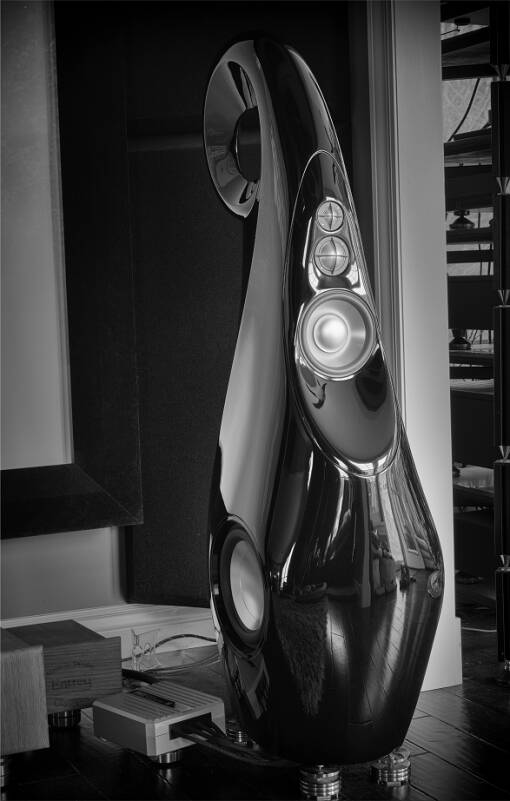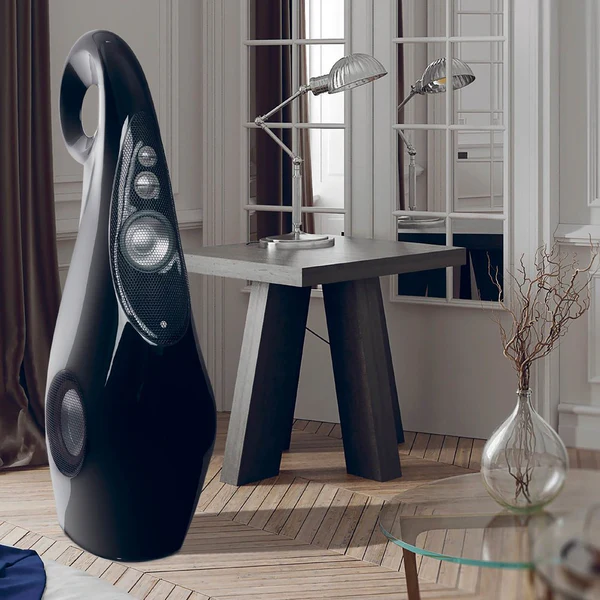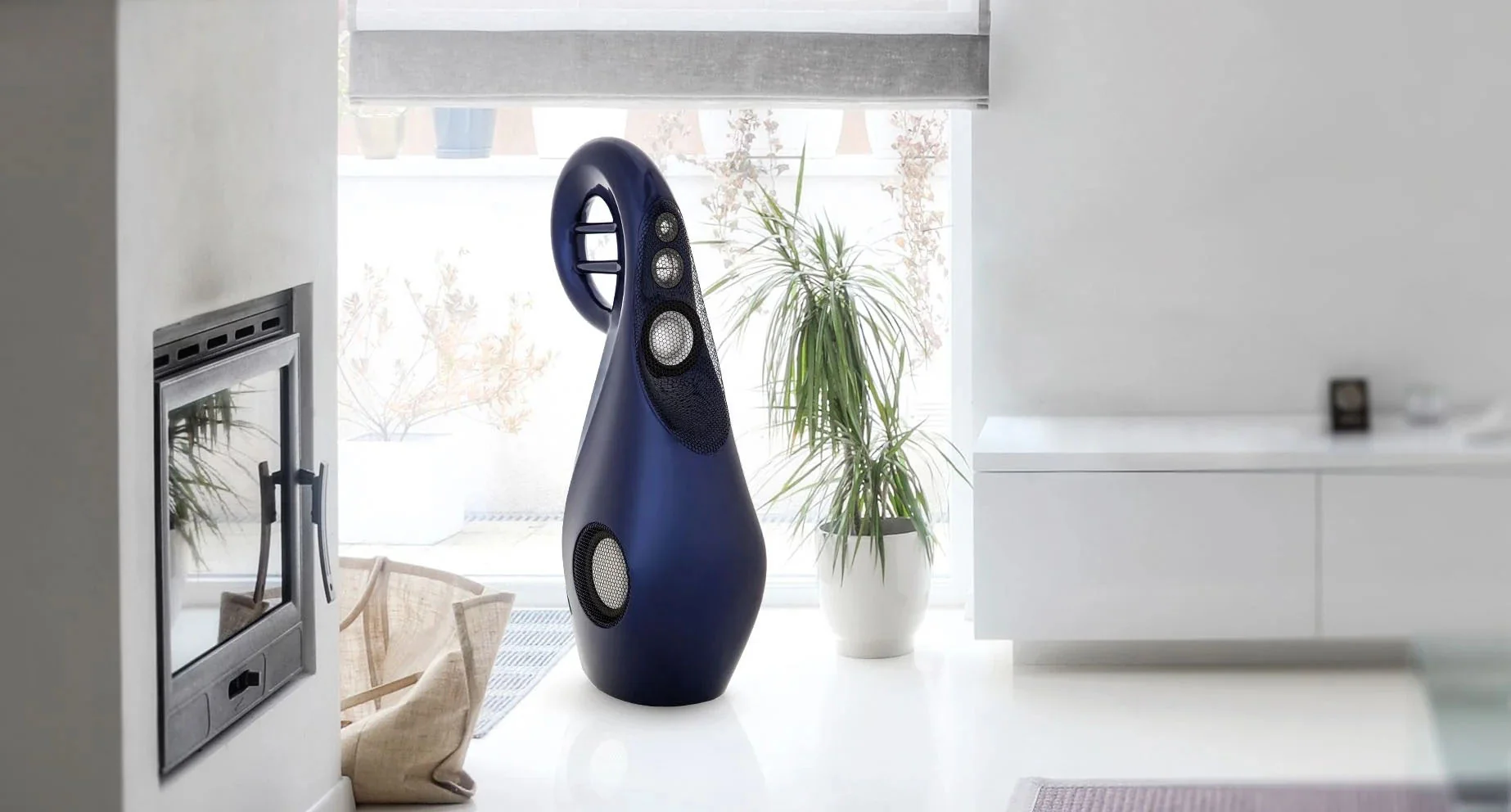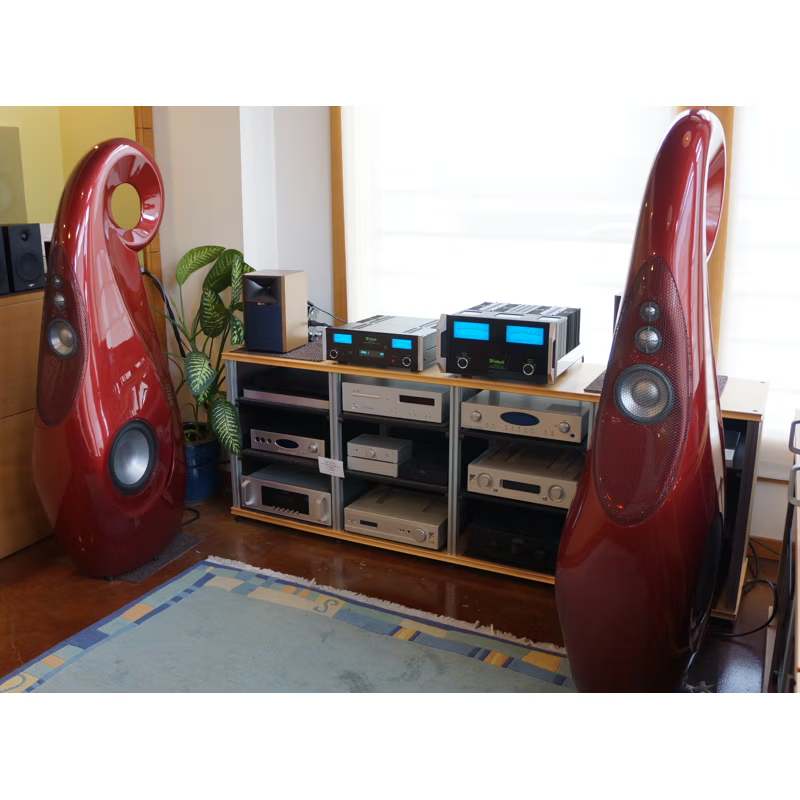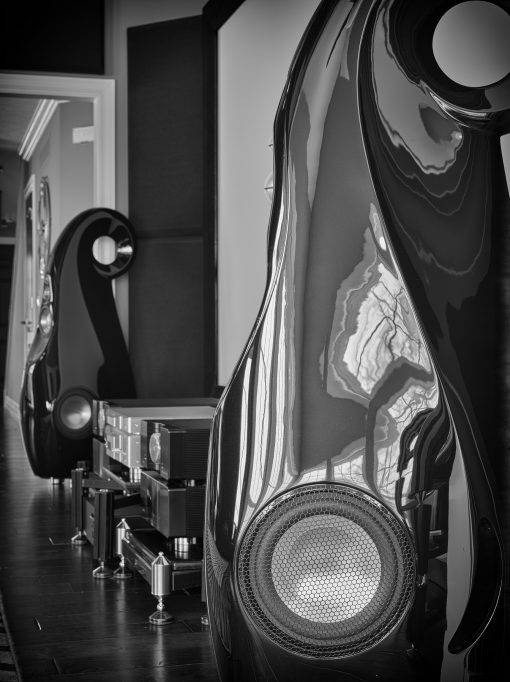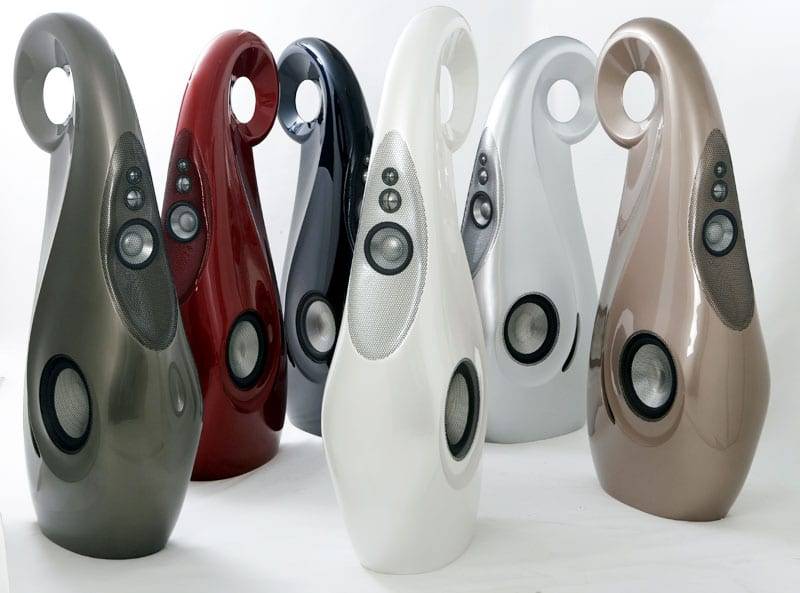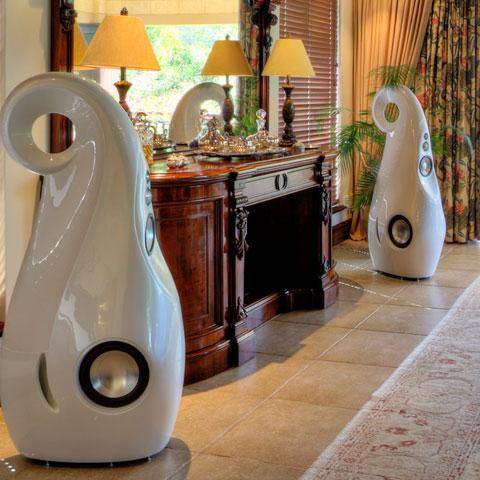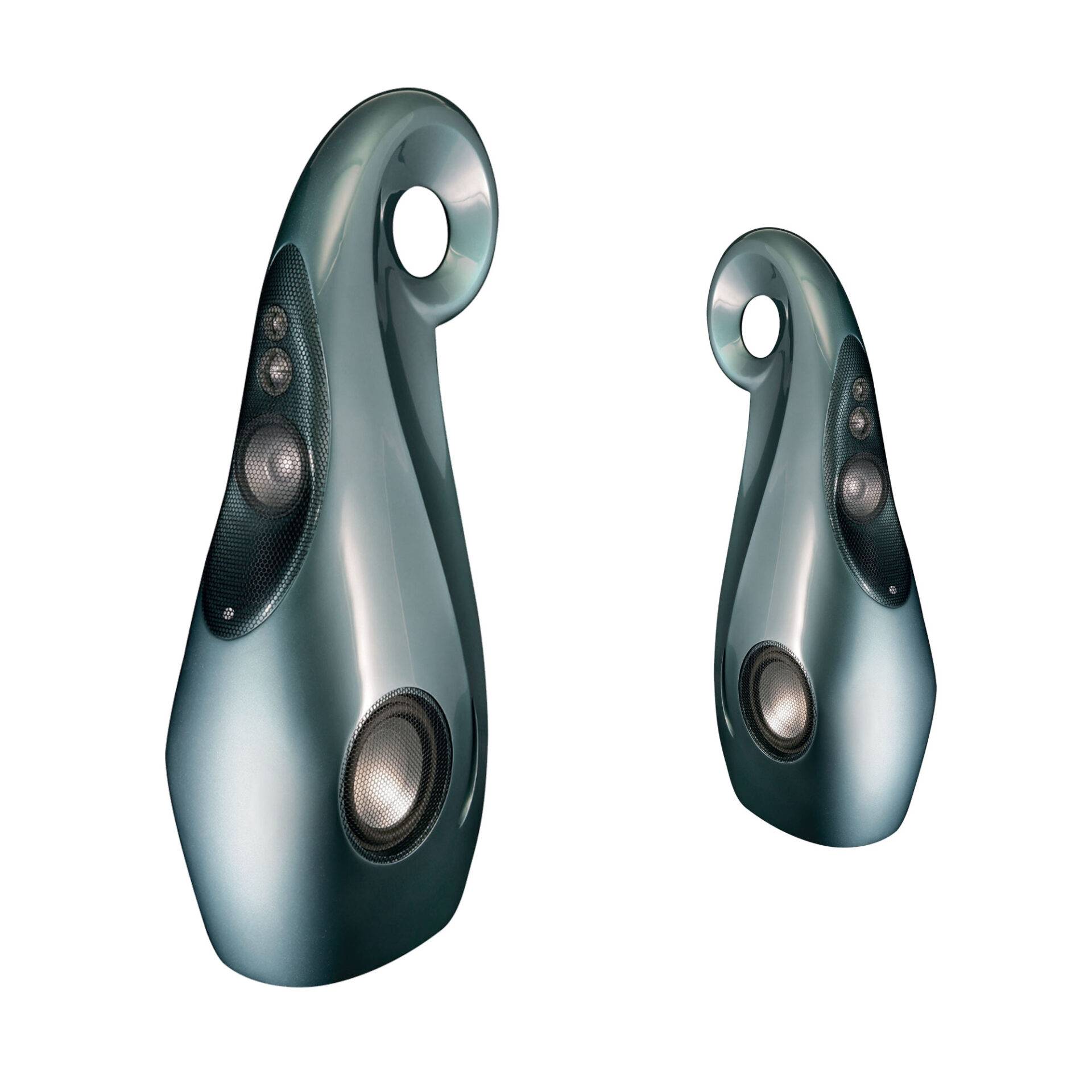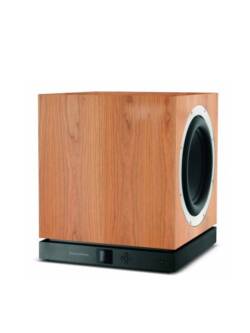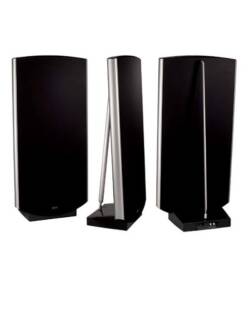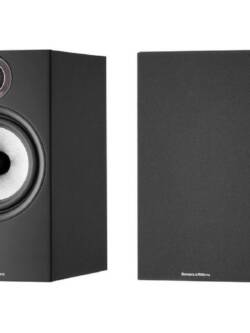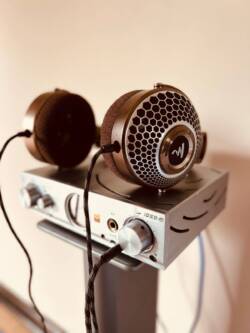Vivid Audio Giya G2 (Upgraded to Series 2)
Original price was: R890,000.00.R345,000.00Current price is: R345,000.00.
| Specifications | Vivid Audio GIYA G2 |
|---|---|
| Configuration | 4-way 5-driver system |
| Cabinet material | Complex loaded carbon fibre filled polymer |
| Drive units | HF: D26 – 26mm metal dome unit with tapered tube loading, catenary dome profile, radially polarized magnet structure & isolating compliant mount. MID: D50 – 50 mm metal dome unit with Tapered Tube loading, catenary dome profile, radially polarized magnet structure & isolating compliant mount. LOWER MID: C125S – 1 x 125mm Tapered Tube loading, short-coil long-gap motor design, 50mm CCA ribbon coil on highly vented former, highly aligned chassis, radial magnet structure & isolating compliant mount. LF: C175 – 2 x 175mm metal coned units with short-coil long-gap motor design, 75mm copper ribbon coils on highly vented formers, highly aligned chassis, radial magnet structures & reaction cancelling compliant mount. |
| Bass loading | Exponentially tapered tube enhanced bass reflex |
| Sensitivity | 89dB @ 2.83VRMS at 1m on axis |
| Nominal impedance (Ω) | 6 nominal, 4 minimum, low reactance |
| Frequency range (Hz) | 29 – 36,000 Hz (-6dB) |
| Frequency response (Hz) | 33 – 33,000 Hz +/- 2dB on reference axis |
| First D26 Break Up mode: | 44,000 Hz |
| Harmonic distortion (2nd and 3rd harmonics) |
< 0.5% over frequency range |
| Cross over frequencies (Hz) | 220, 880, 3,500 |
| Power handling rms | 800W |
| Loudspeaker dimensions | 1,383mm (H) x 360mm (W) x 638mm (D) |
| Net weight | 55kg |
Description
- Details
- Written by Doug Schneider
- Category: Full-Length Equipment Reviews
- Created: 01 July 2020
- Vivid Audio Giya G2 Series 2 Loudspeakers
Price: $50,000 USD per pair.

On a recent trip to the UK, I interviewed Laurence Dickie, Vivid Audio’s cofounder and chief designer. He told me that every Vivid loudspeaker is an extension of his work at Bowers & Wilkins, where he was employed from the early 1980s to the mid-1990s. His work there culminated, in 1993, with B&W’s revolutionary Nautilus loudspeaker, which Dickie had begun designing in the late ’80s. As a testament to how advanced the Nautilus was in its day, consider this: B&W still makes it.
Dickie’s designs for Vivid have advanced even further, which makes reviewing one of his speakers a challenge — there are often many innovations to come to terms with and understand before one can write about them. But the Giya G2 Series 2 ($50,000/pair, all prices USD) is the fourth Vivid speaker I’ve reviewed, and I’m getting used to the routine. It was preceded, in chronological order, by their very first product, the Oval B1 ($14,000/pair, discontinued), launched in 2004; the Oval B1 Decade ($28,000/pair), a souped-up version of the B1 created to celebrate Vivid’s tenth anniversary; and the original Giya G2 ($50,000/pair).

Description
The Giya G2 Series 2 (which I abbreviate to G2S2) is the central of five Giya models. All are four-way, five-driver floorstanders of various sizes and similar appearance and shape — a shape that generates extreme reactions. Imagine a human-sized bowling pin, its top stretched straight up to a point, then curled around to touch the pin’s “shoulder.” Flatten the pin’s “chest” to accommodate the tweeters, and flatten both of its flanks to fit the woofers. Or just look at the photo. I and my wife love the look. Others loathe it.
Below the G2S2 are the smaller Giya G4 Series 2 ($33,000/pair) and G3 Series 2 ($40,000/pair), and above it the larger Giya G1 Series 2 ($68,000/pair) and the flagship of the line, the G1 Spirit ($86,000/pair). (All prices are for the standard Pearl White or Piano Black finishes. Because Vivid finishes its speakers in automotive paints, any number of custom colors can be ordered at additional cost; for the G2S2, these colors begin at $5000 additional per pair.) The G1 Spirit is not part of Series 2 — it was added to the line long after the original Giyas were launched. The G2 has always been my favorite Giya, mostly for its size. The G1 and Spirit are too big for my taste, and for how I think they might look and sound in my room, while the G4 is too small, and the G3 might be only barely big enough.
Like the venerable B&W Nautilus, the Giyas have changed little since the first model, the G1, debuted in 2008. Its Series 2 version is a bit shorter, and fatter at the bottom, to bring its tweeter closer to ear level, but the other Series 2s don’t look much different from their original versions — when I asked Dickie about the differences between the original G2, launched in 2010, and the G2S2, he told me that they’re subtle and not always visible, as described below.
The original Giya G2 and the new G2S2 both have a 1” (26mm) dome tweeter, a 1.97” (50mm) dome upper-midrange driver, a 4.9” (125mm) lower-midrange driver, and two side-firing woofers with 6.9” (175mm) cones. Note that, unlike most speaker makers, Vivid specifies only the diameter of the cone itself, not the diameter of the surround or frame — these drivers are bigger than their specified diameters indicate. All five have diaphragms of aluminum-magnesium alloy. The tweeter is crossed over to the upper midrange at 3.5kHz, which hands off to the lower midrange at 880Hz, which in turn is crossed over to the woofers at 220Hz.

All Giya cabinets are made of layers of vacuum-infused, fiberglass-reinforced composite sandwiching a core of balsa wood. This results in cabinet walls that are thin, light, and stiff — this is done, Dickie explained, to keep the cabinet’s own resonances high enough in frequency that they don’t color the drivers’ outputs. In fact, Dickie told me in an e-mail, he increased the ratio of rigidity to mass in the G2S2 over the G2 not by altering the cabinet walls themselves in any way, but by changing one internal brace “from a commercial grade of glass fibre grid to an in-house made composite sandwich CNC cut to the exact size.” He said this not only provided a better fit; the new material has the same stiffness as the old while being of lower density and requiring less adhesive, the combination of all of which reduces the speaker’s weight. The G2S2 weighs 99.2 pounds — pretty light for its size. At its tallest, widest, and deepest, the G2S2 measures 54.5”H x 14.2”W x 25.1”D, as did the original.
The most visible difference between the G2 Series 2 and the G2 is the addition of permanently affixed protective grilles directly in front of the tweeter and upper-midrange domes, and the Vivid Audio logo set into the front baffle about 7” below the lower-midrange driver. Those protective grilles are in addition to the single removable, magnetically attached metal grille that, as on the G2, covers all three front drivers, and a similar grille for each woofer. Unlike most removable speaker grilles, however, Vivid’s don’t negatively affect the sound, and are attractive enough to leave on all the time, if you prefer. I left them off.

Adding more complexity to the G2S2’s design is how the drivers are mounted. An O-ring decouples each driver from the cabinet, to reduce the transfer of resonances between them. Attached to the rear of the tweeter and midrange drivers is a tube, widest at the driver end, and tapering to a point where it meets the cabinet’s rear interior wall. Dickie invented this for the B&W Nautilus, and has further refined it for Vivid Audio. The G2S2’s entire cabinet acts as a tube for the woofers, which explains its graceful shape — a single tapered tube, its narrower end bent and curled around to the back. Each tube, including the cabinet, is filled with stuffing. This and the cabinet’s shape combine to dissipate the diaphragms’ rear-directed energy so that it isn’t bounced off the interior walls to end up back at the rear of the diaphragm, where it could interfere with the driver’s production of front-directed soundwaves — i.e., the music you hear. The result, according to Dickie, is cleaner, less distorted sound.
The magnets of the side-firing woofers are connected by a single metal rod. This force-canceling configuration was not done in the B&W Nautilus, but is something Dickie has championed at Vivid. It works as follows: Because the woofers are mounted back to back and move in phase, their forces, as they simultaneously move out and in, are equal and in opposite directions. As a result, any forces produced by either driver are largely canceled out, and thus are not transferred to the cabinet, as they would be in a more conventional speaker with all driver(s) mounted on the front baffle. Just behind each woofer is a port in the shape of a thin crescent moon. Dickie told me that the shape of these ports — he calls them “aeroports” — has been refined to something “more aerodynamic” than in the original G2, but the difference is subtle enough that, had he not told me, I wouldn’t have noticed.

Vivid’s R&D work is mostly done in the UK, but all Vivid drive-units, crossovers, and cabinets are made in the company’s factory in South Africa. Among boutique speaker brands, Vivid is rare in terms of making their own drivers — most companies use unmodified or modified versions of off-the-shelf drivers from OEMs. This sort of vertical integration of manufacturing requires high levels of engineering and manufacturing expertise to master the design and manufacture of all those different parts, but it also gives Vivid a high level of control over the quality of the final product, and allows them to be more forward thinking. For example, one change now planned for the Giya Series 2s is the replacement of their passive crossovers with active crossovers and multiple channels of amplification, in hopes of improving their sound.
Vivid specifies the Giya G2 Series 2 as having a frequency response of 29Hz-36kHz, -6dB; impedances of 6 ohms nominal and 4 ohms minimum; a sensitivity of 89dB/2.83V/m; and distortion of less than 0.5%, 29Hz-36kHz. The binding posts, like the original G2’s, are on the bottom plate — the speakers must be tilted far forward to access them.
Systems
When the Giya G2 Series 2s arrived, I first drove them with a Hegel Music Systems H390 integrated amplifier-DAC. My digital source was an Asus Zenbook UX303U laptop running Roon, which I used to stream from Tidal and to play music files from an attached solid-state drive connected to the computer with an AmazonBasics USB link. QED Supremus speaker cables tethered amp to speakers.
For most of my listening, however, the system comprised the components I wrote about in my April column, “After 25 Years — Is This the World’s Best Audio System?,” about how this system I’ve built up is the best-sounding I’ve heard anywhere. I used the same Asus laptop and Amazon USB link, this time connected to an EMM Labs DA2 Reference DAC, in turn connected to an EMM Pre preamplifier with Crystal Cable Standard Diamond balanced interconnects (XLR). The Pre drove a pair of Constellation Audio Revelation Taurus mono amplifiers, also via Crystal Standard Diamond balanced interconnects. The same QED Supremus speaker cables mentioned above connected amps to speakers. Toward the end of my listening I swapped out the EMM Pre for an Anthem STR preamplifier-DAC, with interesting results (see below).
Shunyata Research power distributors and power cords were used throughout all three systems.
My listening room measures about 36’L x 16’W x 8’H, though I use only the front half of that space for listening, which leaves a large, open space behind my listening seat. With all three systems, the speakers and my listening position described the same 9’ equilateral triangle, with almost 4’ between each speaker and the nearer sidewall, and 7’ from the speakers’ rear panels to the wall behind them.
Sound
I first listened to the Giya G2 Series 2s with fellow SoundStage! reviewer Diego Estan, who’d helped me unpack them from their wooden crates, schlep them up to my third-floor listening room, and held them at the right tilt so I could attach speaker cables. We began with the Hegel H390 integrated-DAC.
First up was “Five Days in May,” from Blue Rodeo’s Five Days in July (16-bit/44.1kHz FLAC, WEA), a track Diego and I both know well. It was at a pretty typical volume level — nothing too low, but nothing extremely high just yet. “They sound really good!” said Diego. I played several more tracks we’re both familiar with, and could tell the G2S2s were impressing him more and more. But, having reviewed the original Giya G2s, and knowing that the G2S2s should sound at least similar, I played him a track he knew, but in a way I knew he’d never heard it reproduced before.

“These speakers’ curves make them look kind of delicate, don’t they?” I said.
He nodded.
“Now listen to this!”
I streamed the raucous “Roller,” from April Wine’s The April Wine Collection (16-bit/44.1kHz FLAC, Aquarius/Tidal), first at an average volume level — essentially, what I’d played the Blue Rodeo track at — then goosed it another 10dB, and then, a few moments later, a few dB more. With that final increase of volume Diego’s head went back into the chair and his eyes opened wide — not unlike those videos of passengers in a Tesla Model S when the driver accelerates from 0 to 60mph in just over 2 seconds. He was genuinely taken aback by the G2 Series 2s’ combination of loudness, clarity, and dynamic agility as the drums pounded, the bass guitar grooved, and the lead guitar wailed. As had been others for whom I’d played this track through the original G2s, Diego was shocked and awed.
For me, this quick demo was a not-so-subtle reminder of the original G2s’ unique characteristics, now translated into the new GS2Ss. One was their ability to go from very quiet to very loud, their sound remaining always utterly clean and detailed. I’ve heard only horn speakers scale so widely and quickly while still sounding effortless. Another characteristic was how the G2S2s reproduced Steve Lang’s bass guitar and Gerry Mercer’s kick drum, which respectively provide the visceral wallop and rhythmic underpinning that give “Roller” such infectious drive when reproduced in this way. With one exception, I’ve heard no other speaker at any price replicate such bass control and clarity, regardless of volume. All others distort, and/or sound as if they’re tripping over their feet trying to keep up with the rhythm. The lone exception has been KEF’s Blade Two ($24,999.99/pair), which can hammer home “Roller”’s bass with similar control, and may go even lower in frequency than either version of the Giya G2, both of which hit a rock-solid 30Hz in my room — I felt the Blade Twos reached down to 20Hz, the bottom of the audioband. The common denominator is that the woofers in both models are installed in force-canceling arrays. I can’t help thinking there’s more to the force-canceling technology than reducing cabinet vibrations — it may help give the speakers better bass slam and articulation.

I then played a far less raucous recording: “No Landing (Lucknow),” from Greg Keelor’s Gone (16/44.1 FLAC, WEA). It’s mostly Keelor singing and playing guitar, accompanied by cellist Anne Bourne and tabla player Parijata Charbonneau. I again set the volume loud, so that the musicians seemed to be in the room, about 10’ in front of Diego and me. The G2S2s soared unrestrained, yet remained totally composed and wickedly detailed — as I wrote in “After 25 Years . . . ,” it was the first time I could clearly hear Keelor’s voice being compressed by the engineer in the track’s loudest passages.
Diego left liking what he’d heard, and a week later returned with a hard drive full of his own music. By then I’d hooked up the Giyas to my separates: EMM Labs Pre and DA2 DAC, and Constellation Revelation Taurus monoblocks. At the end of that second session, he said that he’d never heard drumming reproduced with such detail, or heard speakers “disappear” so completely from the room. The latter was high praise — these days Diego listens almost exclusively to minimonitors, which many feel erase themselves from the music more readily than do floorstanders. “There’s no hint of the cabinets in the sound,” he said just before he left.
The rest of my listening sessions with the G2S2s involved the widest selection of music I’d ever used — and always, Diego’s remark about those “disappearing” cabinets held true. The entire time the Giya G2 Series 2s were here, with no track I played did I hear any hint dropped that there was a speaker 9’ in front of me and to the left, and another 9’ in front of me and to the right. The soundstages created varied in width and depth, depending on the recording, but were consistent in all being free from the speaker positions — music just hovered in air. Although it’s more than eight years since I reviewed the original G2s, and can’t be absolutely sure, I believe that the G2S2s might just improve on them in this regard — I don’t recall being quite as enthralled by their soundstaging. I am sure that they outclassed one of the best minimonitors I’ve heard, Magico’s A1 ($7400/pair), a pair of which were in for review at the same time. The A1s “disappear” as well as any other speakers — but they never vanished as entirely as the G2S2s did.

I also realized that the G2S2s favored no type of music over other types, and that while they could shock me when played loud, they were also the most exciting speakers I’ve heard when played at very quiet background-music levels, consistently sounding so open and detailed that the experience was sometimes uncanny. As I wrote in “After 25 Years . . . ,” when I played Lana Del Rey’s Norman Fucking Rockwell! (16/44.1 FLAC, Polydor/Interscope), “I experienced more than a hint of synesthesia — it was as if I were seeing only the recording in front of me — and only the recording, not the speakers or amps or cables or anything else. The entire soundstage looked like a light-yellow haze that extended past the speakers’ outer side panels and a few feet behind their front baffles; and since I know what Del Rey looks like from photos, as the image of her voice hovered in air, an image of her face also appeared.”
My experiences with NFR! went further — as winter moved into spring and I remained sequestered at home by the COVID-19 pandemic, I studied that album, playing it through the Vivids again and again. No detail in that recording was unheard. The G2S2s laid bare everything, which is the definition of sonic transparency — I was sucked into the recording, not only hearing every detail, but experiencing it as if these performances were taking place in my room.
Toward the end of my listening sessions I swapped out the EMM preamp and DAC for Anthem’s STR preamplifier-DAC. The sound didn’t change drastically, though the total price of the system did: the Anthem costs $3999, the two EMMs $50,000. But with the STR, the soundstages of the tracks mentioned above were consistently just a bit shallower, and the sound wasn’t quite as refined. However, the width of those stages, and the way the sound floated so free of the speakers, were unchanged, as was the ability to play every musical genre with aplomb. Perhaps most important was that the sound was still top-drawer — don’t think the $50,000/pair Vivid Giya G2 Series 2s require ancillary gear as crazy-costly as themselves. The Anthem and Hegel taught me that, if you spring for a pair of G2S2s, it might be wise to experiment with upstream gear of all sizes, types, and prices.

Finally, on my last full day of listening to the G2S2s, with the Anthem still in the system, I listened to all the music I could and at last confirmed something I’d been thinking about over the preceding months: the G2S2s’ reproduction of piano was head and shoulders above that of any other speaker I’ve heard, in my room or anywhere else. Whether the pianos were well recorded, as on Kandace Springs’s The Women Who Raised Me (24/48 FLAC unfolded to 24/96 MQA, Blue Note/Tidal) or Lang Lang’s Piano Book (24/48 FLAC unfolded to 24/96 MQA, Universal Music/Tidal), or more processed fare such as Fiona Apple’s Fetch the Bolt Cutters (16/44.1 FLAC, Epic/Tidal), the keystrokes were more incisive, the sound of the instrument was more present, and there was greater clarity than I’d ever heard from any speaker at any price. Not once did the sounds of the pianos on these recordings excite any cabinet resonances, as they do with so many speakers, even very expensive ones. The instruments remained utterly clear — I heard only the sounds of those pianos, with nothing added. This is important to me: I love listening to recordings of acoustic piano, but the sound of the instrument is extremely difficult for most speakers to reproduce cleanly and authentically. The Giya 2 Series 2s soared through these recordings; for me, they’re damn near impossible to beat.
After that last day with the G2S2s, I wrote Laurence Dickie another e-mail, to make sure I’d covered all the changes he’d made, and to see if he’d done anything to the G2S2 that should have been audible in my listening but that I’d missed. He told me that they’d “made small tweaks to the crossovers which just made the drivers knit a bit better,” and “added a shade (~1dB) more to the high-frequency in response to general opinion.” I’d heard no driver-to-driver discontinuity in my listening sessions, so I have no doubt that the five drivers were indeed knitting nicely. But what Dickie said about the highs surprised me. Although eight years is far too long for me to even attempt a detailed comparison of the sounds of the original Giya G2 and the Series 2, the tweeter level is a pretty easy thing to recall. Through all of my listening, the last thing I would have thought was that the G2S2 sounded a touch brighter than the original — its highs didn’t sound any more tipped up than the Giya G2’s had been. Unfortunately, we weren’t able to measure the G2S2 in the anechoic chamber of Canada’s National Research Council, as we’d done with the Giya G2 — like most establishments around the world, the NRC was closed down by the pandemic. Those measurements might have verified that treble lift. But my ears tell me that any increase in the highs that Dickie made must indeed have been only “a shade.”
Conclusion
When a speaker is replaced with a new, updated version, there’s sometimes a wholesale change in the sound, and occasionally in appearance as well. In the case of the Giya G2 and Giya G2 Series 2, neither is true. Although it’s been eight years since I heard the original Giya G2, its successor didn’t feel like a big step in any direction — it looks basically the same, and its sound impressed me just as much. The improvements wrought in Series 2 of the Giya G2 are not revolutionary but evolutionary.

I found the absence of big changes neither surprising nor disappointing. Like Laurence Dickie’s legendary B&W Nautilus, which approaches its 40th anniversary, the Giya G2 was a well-thought-out design, and as good a loudspeaker as I’d heard anywhere — it could have lived on for many more years unchanged, another testament to Dickie’s designs standing the test of time. But the little adjustments Dickie has made that have resulted in the Giya G2 Series 2 seem not to have been at the cost of any of the original’s great qualities, and one thing that has not changed is the price — which is admirable.
I concluded my review of the original version with this: “The Giya G2 is not only the best loudspeaker I’ve ever reviewed, it’s the best loudspeaker I’ve ever heard.” Today, I still say the same thing — this time, about the Giya G2 Series 2.
Vivid GIYA G2 loudspeaker

How many loudspeaker companies build all their own drive units and fit them into ground breaking cabinets? And how many of those companies are genuinely breaking new ground? By my calculation the answer is very few indeed, and of those Vivid Audio has the lowest profile. I mean you don’t need very many fingers to count the number of speaker companies that make their own tweeters and there are even fewer that go to the lengths that Vivid does when it comes to cabinet construction. The ‘box’ that the Giya G2 inhabits is made from two skins of reinforced glass fibre, which sandwich a core of end grain balsa. That is 12mm thick slices of balsa in 50mm square blocks and triangles individually laid up by hand. The result is a very curvy and distinctive cabinet on the outside that is both stiff and light and which has no sharp edges to cause diffraction. It’s genuinely leading edge stuff.
But what’s the deal with the Giya G2? It looks just like the G1 that came out in 2008 and appears to have the same drivers. Put the two side by side however and you will see that it’s a smaller version of the G1, with half the internal volume and 80% of its height. This is still a decent size loudspeaker that stands a metre and third tall but it’s easier to accommodate than a G1 because the bass drivers are 50mm smaller in diameter albeit using the same motor unit, and thus don’t go quite so low or so loud. This is not to say that they don’t have grip, grunt or girth.
Designer Laurence Dickie’s explanation for the G2’s unusually strong bass is that his work in pro audio for Turbosound has taught him that using oversized magnets on lightweight cones delivers this result. He compares it to the way that a large engine in a small car will give you more control, if it’s driven properly. The drive in this case being the crossover design. In Dickie’s B&W days (he was responsible for the original Nautilus) this approach was described as ‘over shoved’ – which doesn’t sound very positive – but in this instance it brings considerable benefits. The bass has many of the qualities you get with active loudspeakers, including impressive extension and power; some call it ‘grip’, others ‘slam’, but essentially it’s a combination of power and speed that is hard to achieve with passive designs.
It’s slightly at odds with the graceful design of the cabinet, but the G2 is a bit of a beast. Power handling is quoted as a whopping 800 watts and its delivery is so clean that I can easily believe it would be able to take this sort of energy without showing any sign of strain. I certainly encountered nothing of the sort at the levels I wicked them up to.
To get back to the G2’s make up, it’s a four-way, five driver system with all metal units and catenary domes on tweeter and midrange. I noted that the tweeter dome is reinforced with a carbon fibre ring which is something that Bowers used to do in its 800 series because if stiffens the driver sufficiently to add a very worthwhile increase in high frequency extension before break-up, in this case the figure quoted is 44kHz. Tweeter, mid and mid-bass units all have tapered tube loading and all the cones have maximum ventilation through the basket and even the coil former which relieves pressure behind the central dome. The two bass drivers are braced against one another in a reaction cancelling arrangement that doesn’t rely on stiffness in the enclosure, in fact the units are mounted on ‘O’ rings to minimise the transmission of energy (as are the rest of the drivers for that matter). The bass drivers also have a massive 50mm of mechanical travel, something that Dickie must have picked up on in his day-job.
Given that carbon fibre is all the rage these days I asked Dickie why Vivid hadn’t chosen this material instead of GRP for the cabinet skins. He agreed that CF is more of the moment and could look great but in practice its only real advantage would be a reduction in weight, which as this is not a car, would not enhance the potential sound quality of the speaker. The current vacuum infused GRP and balsa cabinet accounts for less than half of the finished speaker’s 55 kilo mass which is arguably light enough. There is some carbon fibre in the G2 however; it’s used to form the base, presumably because it can be moulded into more complex shapes with ease. The bi-wire cable terminals are right underneath the speaker which makes for a great looking rear end but a tricky cable swap if you’re on your own, I had to lay them on some cushions to do the job. There are six threaded inserts for custom made stainless steel spikes but their use is optional and I went with the ease of positioning that the smooth base confers. Vivid also supplies high quality terminal jumpers for those preferring to single wire.
The first thing that struck me about these speakers when I got them up and running was the character of the recording on the Grateful Dead’s Blues for Allah. Some speakers make the Audio Fidelity pressing of this album sound smooth and luxurious, perhaps a little bit more so than is likely to be the case with such a vintage record. The G2 reveals the warmth of the recording but also the unusual way in which the drums were laid down and the fact that this instrument is the key to the overall sound of this most jazzed out of Dead LPs. The record sounds much more of its age as well with lovely, chewy bass guitar notes and some top quality noodling from Garcia et al. A few more albums in, and it’s clear that the G2 is a very fast speaker. There is no sense of overhang or smearing of timing, yet unlike many examples of the breed, it is also devoid of forwardness. The speaker’s intrinsic character is totally clean which leaves acres of space for the qualities of the music to shine through.
When that music contains a emotional message you know all about it, in this case Laura Marling delivered the goods on her A Creature I Don’t Know album which is replete with fine detail yet strains at the compression on her voice when she raises it. Recording character both good and bad is obvious with the G2, yet this only reinforces the intensity of the performance so it’s been applied in an appropriate manner, enough so to provoke comments like “lummy and blimey jings, this is powerful stuff” from yours truly.
The speed applies across the band and does not require high power amplification to be enjoyed, I use Valvet A3.5 class A monoblocks and their 50 watts are enough to deliver bass lines that know how high when they are asked to jump. This was readily apparent with all sorts of music including the jazz blues of Conjure’s Music for the Texts of Ishmael Reed. This densely packed recording reveals the various layers involved in its creation as well as its analogue nature even though I was playing a 24/88.2 HDTracks file. Cleaner, fresher pieces like Samuel Yirga’s Habasha Sessions are even more real, in fact at low level this sounded truly magical, totally immersive, natural and effortless.
As you might expect from the aerodynamic shape of the enclosure imaging is a distinct strong point, Dickie suggested they be toed in so that the axis crossed in front of the listening seat which gave excellent stage width in my room but I preferred the tonal balance when sitting at the apex of the triangle with both speakers pointed straight at me. With a lot of speakers I find this set-up uncomfortable but the smooth, clean mid and treble on the G2 means that you can listen like this at any level you fancy and not encounter anything undesirable, unless its on the record of course. Something of this nature surprised me by turning up on ‘Keith Don’t Go’ the Nils Lofgren live track that is in danger of becoming a new Private Investigations on the demo front. This was presented as a totally coherent whole by the G2s; where many speakers deliver lots of scale but little image focus, this time it’s a man playing a guitar (with considerable skill) and both are in one spot in time and space. What you don’t usually hear is the limiting applied at the crescendo, at least not to the extent that the Vivids reveal, all commercial recordings are compressed to some extent but so are a lot of loudspeakers, that is not the case here.
This track also revealed the total lack of cabinet coloration from the G2, a quality that can be heard in the extra acoustic space available for notes to stop and start in – the fact that they end when they should being the key here. The other tell-tale sign is the noise floor being lower than it usually seems, cabinet contributions are a form of noise so when they are dramatically reduced you can hear quieter notes and more note decay and it’s rather addictive. So much so that the next pair of speakers I put on sounded positively crude despite their four and a half grand price tag, I appreciate that the price of that speaker is significantly less than that asked for the G2, but the difference was so great that it took several weeks to re-calibrate my expectations.
With music that has genuine dynamic range and depth of image such as Rachmaninov’s Symphonic Dances the power and scale of the orchestra is delivered in astonishing realism. This is where you really start to wonder how such low bass can be so well controlled. It gives the soundstage extraordinary depth and scale and the music real fear factor, I don’t think this piece was on an album called the Power of the Orchestra but it should have been.
Despite the phenomenal results I achieved with the G2s, I couldn’t help thinking that better amplification would have got more out of them. But try as I might I couldn’t get hold of anything truly suitable in the time available. I had my eye on the MSB S200 power amp that had made a brief visit a few months earlier, that has the power and finesse to do this speaker justice, I think. There were times when a bit more bite on leading edges would have helped particular tracks and a good class AB amp would likely provide that. I tried alternative cables and these enhanced certain qualities but this is such a revealing speaker that you can hear what’s missing rather easily.
Wyclef Jean’s ‘Thug Angels’ was one of the tracks that put me on the quest, its bass had far more subtlety than usual but not quite as much slam, something 200 clean watts would undoubtedly deliver. But with this track you are talking about a studio composite, a sound that has no real absolute. With a string quartet recorded with an eye to fidelity the result was as good as I have ever got. The instruments sounded totally real and provoked the realisation that the G2 has the finesse of an electrostatic combined with the power and dynamics of a boxed speaker. Very rarely can cones and domes deliver the softness of real strings complete with the acoustic of the studio so effectively, and even less common is one that can go from soft to loud and back again in such immediate and effortless fashion.

A lot is made of the wonders of 3D televisions, but even the best deliver a pretty poor facsimile of the real thing. With a speaker like this you are far closer to experiencing a solid presence in the room and you don’t even need special glasses!
I got a superb result with the Vivid Giya G2, a better one it seemed than that with the G1 a couple of years ago. Although I put this down to mostly better ancillaries in the system and the advent of computer audio, but it’s also likely that the slightly smaller size of the loudspeaker system suited the realistically sized room better. Suffice it to say that both are world class loudspeakers that should be considered by anyone looking for the very best that a sound system can deliver.
